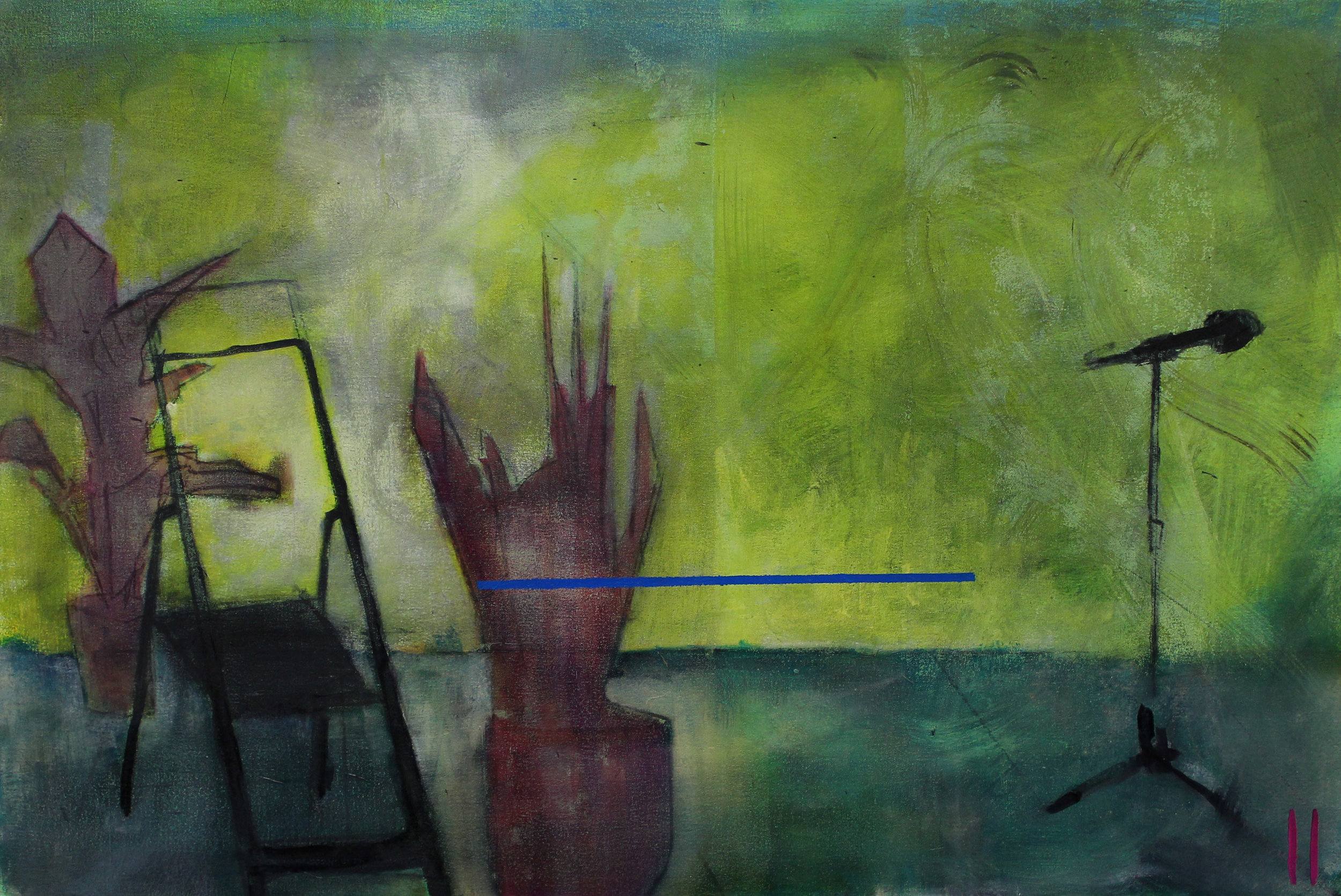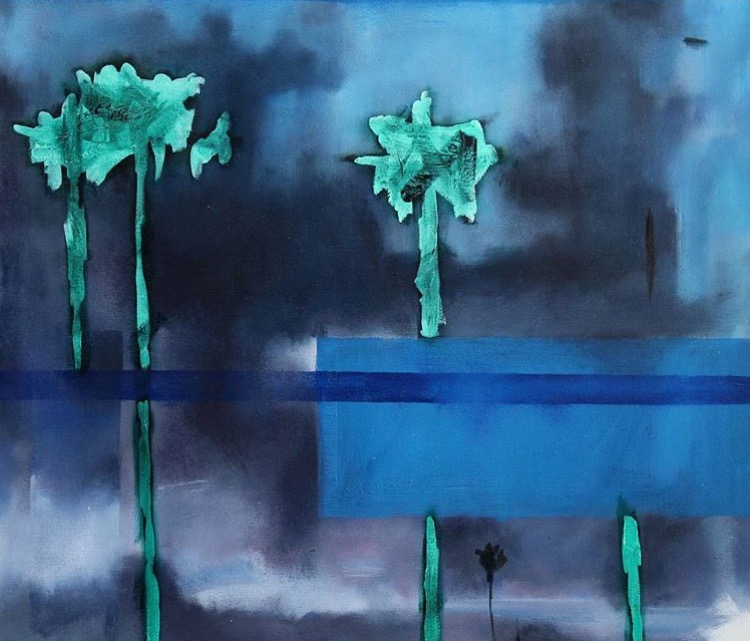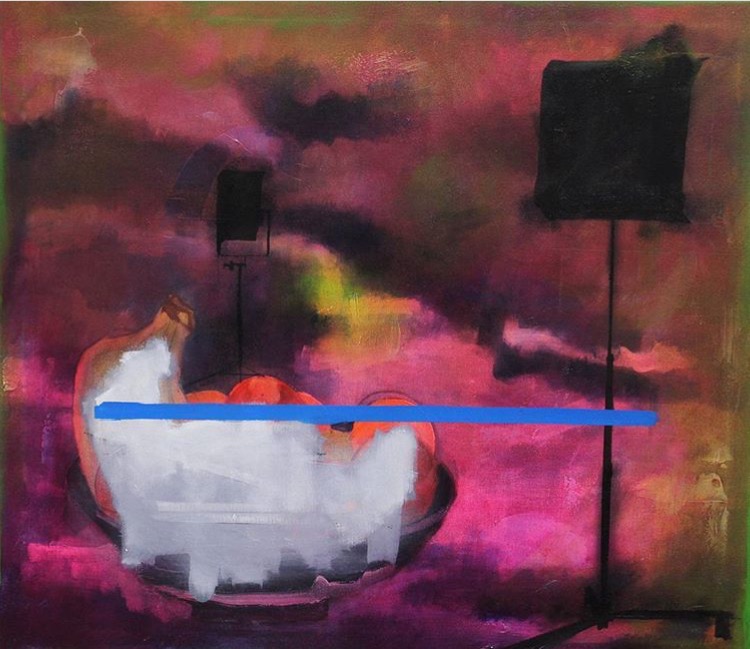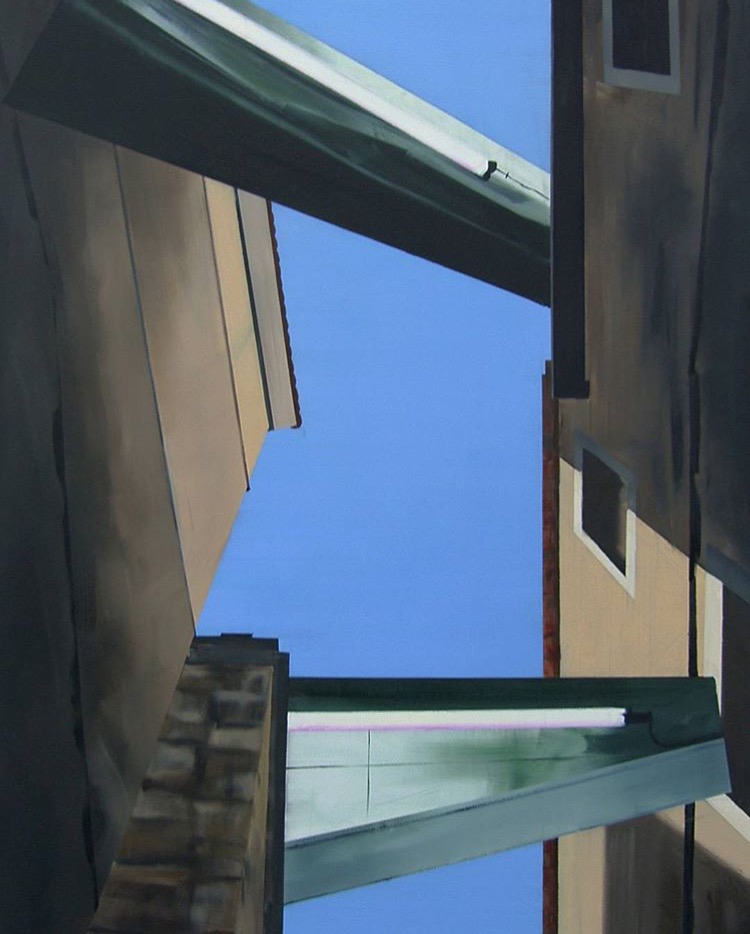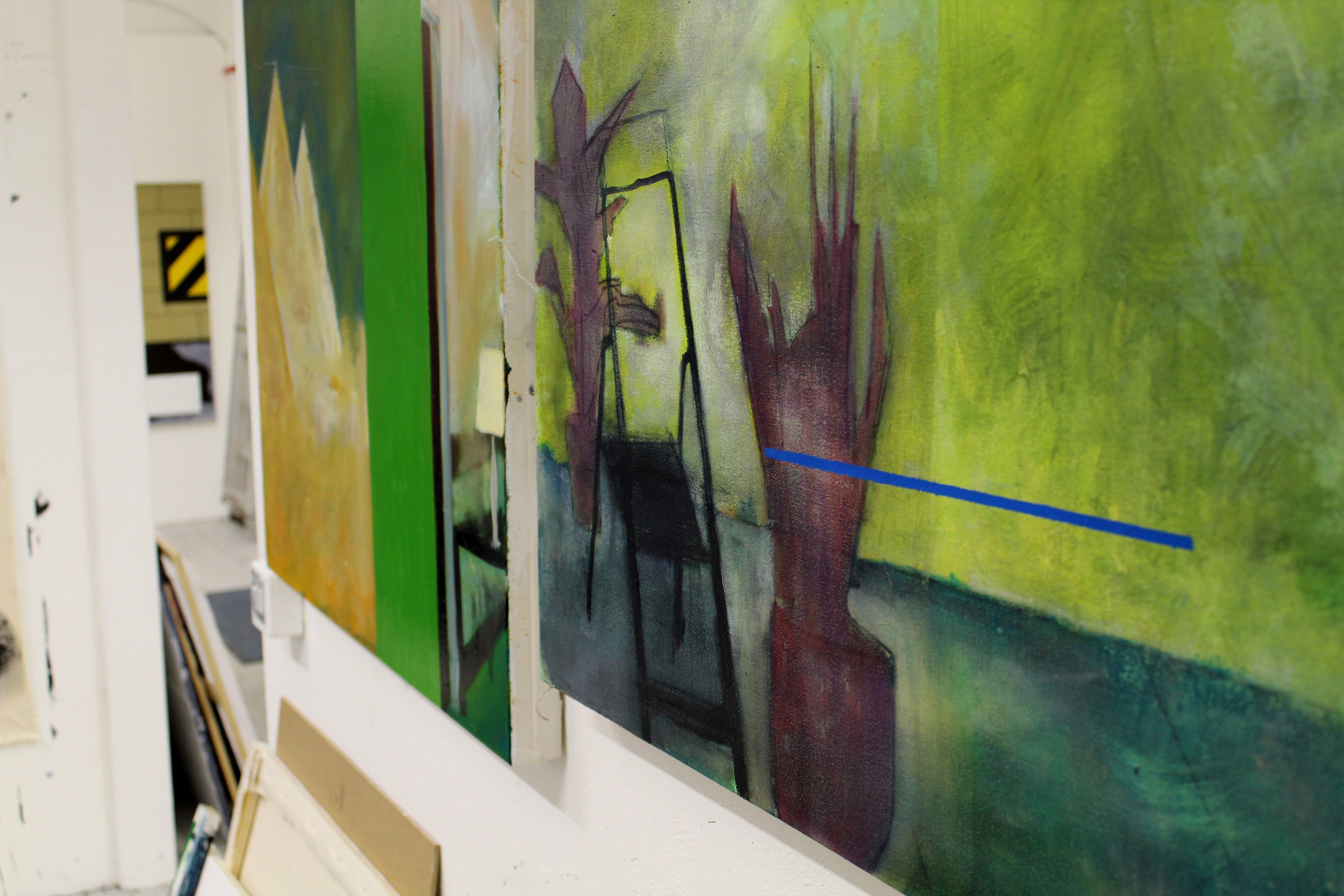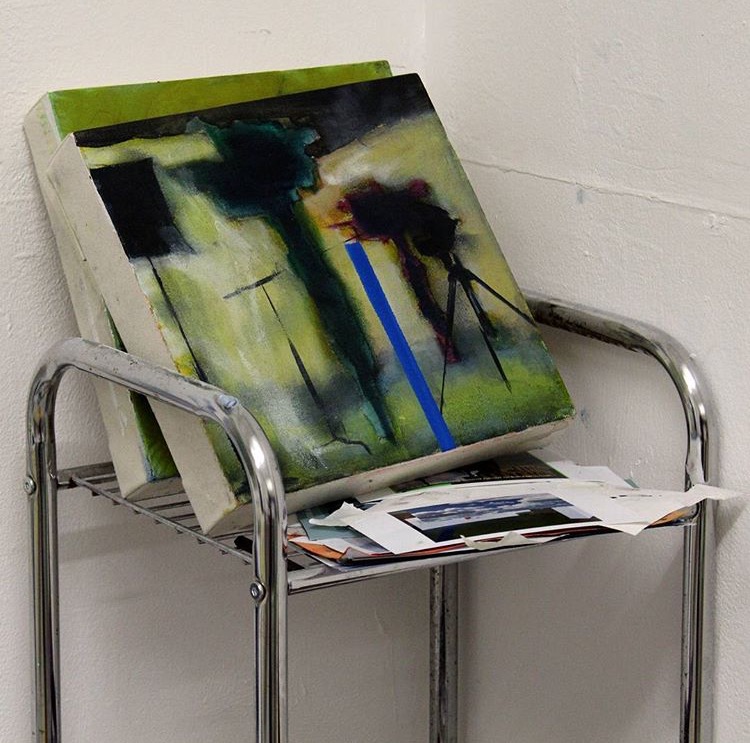A Space Oddity: In Conversation with Artist Will Wilford
A Space Oddity: In Conversation with Artist Will Wilford
By Frances Crossley @frannycrossley
In Will Wilford’s ‘The 11th Hour’, the artist’s exploration of ‘human absence’ – a theme that remains a source of constant exploration – is wholly realised. Long, tapered tree trunks eerily pierce the horizontality of the compositional space. Wilford beautifully renders the distinctive shapes and lines of a palm tree’s trunk in his subtle personification of their non-human form. Alien in their inverted colouring these palm trees create a conflict, a contradiction in their own nature. Wilford has created a credible alternative to the human figure in a space devoid of human complexity. In ‘The 11th Hour’ nature has taken an alternate course.
In this painting the trees stand together to form a collective body and though their tree-like aesthetic is distinct, the anthropoidal nature of their form is truly unique. In a likeness to the sculptural drawings of Henry Moore – where in an almost preparatory practise Moore studied the shifting nature of human form – Wilford imitates the apertures and caves of a tree only to transpose them onto the shape of a human body. The mechanism of the interior becomes more assertive and in turn influences the form, the design of the exterior composition. Wilford inventively creates fictional pictorial spaces that visually hum, their structural integrity informed by a tension that vibrates through the multiple layers each of his works possess.
“I enjoy the idea of art as a sort of cultural oddity, an object that operates experientially in a manner that no other product of culture does … my painting practice works to be the host of varying disparate ideas, the paintings acting as a physical realisation and link between areas of research I find interesting” (Will Wilford, January 2017)
In the study of an artist who values painting’s ‘capacity as a medium to fictionalise a subject’, it appeared interesting to me to delve into the themes he continually addresses: human absence, human presence and the exploration of architectural spaces devoid of human context or history. Perhaps by taking these themes and considering them against Wilford’s own context as an artist, a greater understanding of his work can be achieved. In this series of works repeated motifs are used and given new meaning – ‘pause’, ‘rewind’ and ‘mute’ symbols, large set lights associated with cinematography and his distinctive palm trees. Wilford himself admits to creatively ‘playing with the implication that static images are operating (in his works) in a sensory manner beyond their capacity’. In this interview, we discuss how Will’s art came to be, his influencers, the precarious nature of his practise and how an education should never be undervalued in the making of art.
Frances: Introductions first … who are you Will Wilford?
Will: I am a painter currently based in Bath, UK, undertaking an MFA at Bath School of art and design. I make paintings that seek to address themes of fiction, architecture and a consumable aesthetic.
Frances: Can you remember what initially made you interested in art and who your early influencers were?
Will: I think much like many children, my first interest in art came from discovering a bit of ability in drawing or painting. Hopefully you are then encouraged, and that feeling of reward you get from creating something sticks, and you never really get rid of it. I remember my parents having a big print of Picasso’s ‘Blue Nude’ in our living room, I remember being bewildered by it when I was very young as it showed a type of painting that conveyed an aura, rather than merely depicting something. I feel this has had an influence on my approach to art, if not then it definitely lodged delayed existential crises somewhere!
Frances: Name one painting/artist/exhibition you experienced in your youth that made a considerable impact on your future artistry.
Will: I had a big interest in classical and modernist painting as a child and was a frequent visitor to The National Gallery. I remember George Stubbs’s ‘Whistlejacket’ really having an effect on me back then, perhaps due to its sheer scope; as did Henri Rousseau’s ‘Surprised!’ Perhaps I should be painting animals!
Frances: If speaking to a young adult considering the same choice that you made, to study Fine Art at a university level – Will is currently doing an MA in Fine Art at Bath Spa School of Art and Design (MFA, 2017) – would you recommend the experience?
Will: I most certainly would, though this is not to say that I feel an artistic education is necessary for an artistic career. Having said that, there is air of criticality, community and encouragement (hopefully) that going to art school provides; I think this can be quite often hard to replicate outside of one.
Frances: In your well-versed opinion, does a form of academic training better equip you for taking on the challenge of becoming a professional artist?
Will: Certainly, looking at other artists and friends who have had training and gone onto success, they have an element of confidence and critical awareness, a lot of which boils down to going to a successful art education I feel.
Frances: You describe your practice as you effectively appropriating your work in the role of host for your varying disparate ideas. You also describe your paintings as the physical realisation of said ideas and the link between your different areas of research. What does the physical practice of art making mean to you as an artist?
Will: Well, I think there needs to be an inherent justification for any art object, and for me the physical practice of art making has become this justification in a way. Through collating my interests and thoughts into something physical I feel that there is an element of the artwork having a purpose, it gives it something unique to communicate.
Frances: What kind of space is your studio? To me, as someone studying Art History, an artist’s workshop/studio is almost an imagined space. A space in which the artist, an elusive figure, can endlessly create. I’m sure it’s far less magical to you! Is your studio a cherished space?
Will: It’s messy! And probably quite hazardous too… But yes, you are right, being there every day it inevitably becomes a practical space rather than a romantic one. The idea of the secluded artist working passionately alone in their studio is a myth I feel, and the reality of having to go in and make something every day pulls apart that romanticised element.
Frances: A medium such as painting or a profession such as ‘painter’ could potentially seem otherworldly to some members of today’s society. Does it feel like you are constantly translating the meaning of your work or the medium through which you create it, for a new age?
Will: I feel perhaps not so much translating my work but rather addressing it in the themes I am interested in, digital influences are widespread in modern culture and art is no exception. There is a particular ‘slowness’ to painting in both its production and consumption that I feel is at odds with the rest of consumable media today.
Frances: Have you ever had to defend it?
Will: Perhaps not so much defend, as people are generally quite polite, but definitely elaborate on it…
Frances: Painting holds a certain historical weight. In your ‘Artist Statement’ you explain that, to you, a painting is ‘an object that operates experientially in a manner than no other product of culture does’. Is it important to you that painting remains an important and relevant medium?
Will: Yes, very important! As mentioned previously I feel that the ‘slowness’ of painting is completely at odds with the rest of visual culture. I think that there is a need for painting now as much as there ever was, if only just as a method to offset the rate at which we consume things these days. The artist Dexter Dalwood talks about this a lot in his practice, and deliberately makes work that take a long time to consume experientially. I think this is important, and is something more artists need to address.
Frances: ‘Cinematic image, fiction, human absence and architecture’, are all varying themes that can be found repeated throughout your body of work. Can you explain the defining concept that links these themes together aesthetically?
Will: I guess I’m trying to make the work itself the connecting element, to make a painting into an object that acts as a physical and metaphorical link between disparate ideas. I want the purpose of an artwork to be intertwined with this and for it to work as a justification for an art object. I will let you know in a few years whether this works or not!
Frances: How do these themes resonate with you personally?
Will: They’re all things that I have an interest in personally, and want to see realised in an art form. The real resonation with me personally I guess comes down to the visual appeal of the subjects, and the way in which I could see them translated into painting.
Frances: The aesthetic of your work has visibly changed. From the depiction of architectural spaces devoid of people where geometric forms dominate the compositional space, to the organic personification of palm trees in works such as ‘The 11th Hour’. Can you elaborate on this transition? Did it feel like artistic progression or was it mirrored by change occurring outside your creative world?
Will: It felt like artistic progression and the logical way to take things forward. I was beginning to feel a bit confined by consciously sticking to one subject matter (architecture), so I decided to just let things flow naturally and figure out what clicks afterwards. I ended up with this palm tree motif recurring in my work, I had been reading a lot of philosophy at the time on the ontology of fiction, and these palm trees I realised had become emblematic of this.
Frances: Do you see these two notably different aesthetics as two different periods in your burgeoning career? If so how would you entitle them?
Will: Perhaps not notable periods but I do see a distinction in hindsight! If they had to be given titles I would say architectural ‘spaces’ and ‘consumables’.
Frances: Can you explain/elaborate on the term ‘Theoretical Collage’ (used by Wilford in his ‘Artist Statement’). Personally, this is a phrase I think you should consider coining! Will Wilford on the ‘Theoretical Collage’ or even encourage ‘theoretical collaging’ as terminology in relation to your artistic practise!
Will: Perhaps you are right! I suppose it has a nice sound to it. It is quite a new idea in my work and is something I am looking forward to taking further. By it I mean the idea of taking snippets of different ideas and areas of research and shoe horning them in a way together to inform an image. There is a capacity of an artwork to force you to consider unrelated things holistically, theoretically and visually, just through putting them in the context of being art. I think the acknowledgement of this can form the basis of a working method.
Frances: In a social climate where youth is viewed with such prevalence, it is interesting to see how more and more young artists are starting to rise in visibility then after their work gains traction, they quickly disappear. As a young artist, what do you make of this? Do artists much like movements seem to buck a trend?
Will: I remember reading a statement by Michael Craig Martin somewhere, he was talking about the ups and downs in popularity his work has had over the years and how his career was really forged through sticking at it. So, I guess this fact that many young artists are appearing and disappearing seems perfectly natural, the only difference being that youth is trendy with contemporary art, people are having the ups and downs early on in their careers.
Frances: I know this is a big ask BUT can you describe your work in a single phrase or compact statement that embodies its full creative scope?
Will: The creation of things that (hopefully) solicit interest!
Frances: And lastly … has anyone ever described your work in a way that has particularly surprised you?
Will: I overheard someone once saying that a painting of mine gave them a headache, I never found out for what reason!
For more information on Will Wilford and his work …
Instagram: https://www.instagram.com/willwilford/
Website: http://www.willwilford.co.uk/



